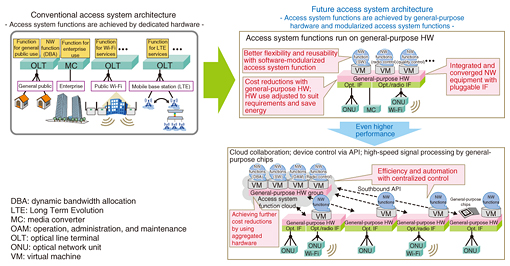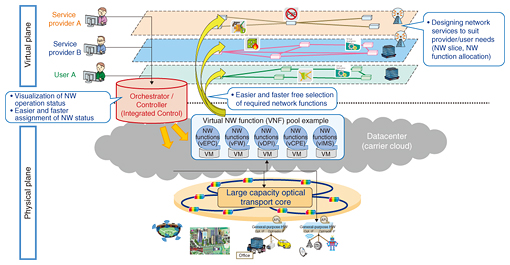 |
|||||||||||||
|
|
|||||||||||||
|
Feature Articles: NTT Tsukuba Forum 2015 Workshop Lectures Vol. 14, No. 4, pp. 22–28, Apr. 2016. https://doi.org/10.53829/ntr201604fa3 
NTT′s R&D Activities Focused on NetroSphere ConceptAbstractIn February 2015, NTT announced the development of a future communication network concept called NetroSphere that is aimed at providing a wide range of rapid, flexible, low cost, and secure services to customers and service providers. This article presents an overview of the concept and the research activities that NTT laboratories are carrying out to bring it to fruition. These Feature Articles are based on presentations made at the Tsukuba Forum 2015 Workshop held on October 16, 2015. Keywords: NetroSphere, separation and combination, service co-creation network 1. IntroductionIn 2012, the NTT Group announced its medium-term management strategy Towards the Next Stage [1]. The group had previously focused on the idea of being a provider that started up its own services, but with this management strategy it shifted its focus to transforming markets and its own business models. The idea was to meet customer needs with added suitability, simplicity, and security so that customers would select the group as a value partner. For the Towards the Next Stage 2.0 strategy announced in May 2015, the group proposed a business-to-business-to-X (B2B2X) business model as a means of furthering market development and accelerating the group’s transformation into a value partner [2]. The specific model reported here was the Hikari* Collaboration Model, for which the main ideas were strengthening the collaboration platform, using cross-group projects to form partnerships with a wide range of business entities, and creating high-value-added services and new business models with our partners by serving as a catalyst in order to achieve sustainable growth [3]. The next step is to take a new look at the entire network concept by further advancing this model.
2. Limitations of conventional network developmentUp to now, the approach used to develop carrier network systems has been to develop dedicated equipment for each service and function and to combine them to form networks. This approach is called silo development since components of dedicated hardware and software equipment are integrally configured and individually optimized for each service and function. With this type of development, however, the following problems need to be considered. (1) It is difficult to add or change some services immediately even if the additions or changes are minor because their supply depends on the roadmaps of the vendor’s products or technology, or because the added functions will affect the system as a whole. (2) Developing individual carrier-grade hardware and software for each piece of dedicated equipment will keep capital expenditures (CAPEX) high. In addition, the need for multiple pieces of dedicated equipment will result in high operating expenses (OPEX). (3) Sharing computing and other resources between different types of dedicated equipment makes it impossible to maintain resource flexibility, thus producing inefficiency. (4) It is difficult to provide service systems when certain components that make up the systems cannot be procured. Some system parts govern the end of life (EoL) of the entire service system. For example, it will be very costly to renew the entire system when a subsystem (such as the Internet protocol system) in a piece of dedicated equipment becomes obsolete. We expect that in the future, extending the B2B2X model will result in an increase in the number of service types that are offered and in turn, the volume of traffic, and this will ultimately impose limits on the conventional silo development and dedicated equipment operations because it will increase the number, functions, and types of dedicated equipment that are needed. We consider that network functions virtualization (NFV) [4] is an effective means of broadening such limits. We are therefore looking ahead and focusing on virtualization as one of NTT’s principal research and development (R&D) objectives. The NetroSphere concept has been developed with the aim of implementing networks that will enable these limits to be surpassed. 3. NetroSphere concept and architectureThe NetroSphere concept was formulated and announced in February 2015 [5]. There are three aims for the concept. The first is service co-creation, in which we hope to quickly satisfy the needs of a lot of partners through B2B2X collaboration. The second aim is to achieve a drastic TCO (total cost of ownership) reduction. Specifically, we hope to reduce CAPEX and OPEX by increasingly using general-purpose equipment so as to realize a maintenance-free and EoL-free network. The third aim is open innovation. Although NTT laboratories have conventionally developed network equipment, our goal here is to establish and expand partnerships with a wide range of partners including overseas carriers and vendors from the concept planning stage of NetroSphere. These aims can be achieved through modularization and materialization of various network functions, enabling them to be combined flexibly and in an on-demand manner through operations. The key ideas here involve three separations and one combination (Fig. 1). The first of these, separation of optics and electronics, means there is a maximum separation of the optical and electronic parts that compose the network structure. This will make it possible to minimize electronic processing so as to establish a simple and permanent infrastructure, and to reduce energy loss through optical-to-electrical conversion. The second, separation of functions and equipment, means modularizing and materializing network functions through software running on general-purpose servers and general-purpose switches, thus enabling flexible and quick responses to customer needs. The third, separation of resources and equipment, means separating network resources from equipment to enable improved operational efficiency and reliability of equipment. This can be expected to eliminate the resource allocation inefficiency seen in silo development and dedicated equipment operations, particularly from the standpoint of operational efficiency. The combination of these separated network elements under the control of the operation provides the required network service functions and capacity, flexibly and economically.
The technology development for NetroSphere is oriented toward increasing network flexibility through strengthened cooperation among multiple services and technology by utilizing general-purpose products. Another aim is to reduce costs by commonizing specifications for and automating operations of general-purpose products for carriers (Fig. 2). The main point here is modulation achieved by separation, and for the future we plan to study ways to modulate components up to the sub-device level in order to meet the needs of our customers more flexibly.
4. Approaches to achieving NetroSphere conceptHere, we briefly describe the main element technologies for achieving the NetroSphere concept: the server system MAGONIA, the transport system MSF (Multi-Service Fabric), the access network system FASA (Flexible Access System Architecture), and the operating system OaaS (Operation as a Service)/Integrated Control (Fig. 3). Service network flexibility can be enabled by modularizing and combining the server system, transport system, and access network system functions provided by MAGONIA, MSF, and FASA, on the OaaS/Integrated Control operating system.
4.1 MAGONIAUp to now, service functions have been implemented using individual components of dedicated equipment, but with MAGONIA, it is now possible to implement them as software on general-purpose hardware, with the aim of achieving flexibility and reducing costs (Fig. 4). In MAGONIA, application programming interface (API) specifications for distributed processing platforms that form the n-active (N-ACT) cluster mentioned below are publicly disclosed, making it possible for anyone to design API-compliant middleware and software on the basis of service logic. It should be noted that from the viewpoint of attaining carrier-grade reliability, it has been necessary to have an active and standby (ACT-SBY) redundant configuration in each piece of dedicated equipment. With MAGONIA, however, each active system takes the redundant configuration of an N-ACT cluster so that it works as the standby system for another active system that forms the cluster. This can produce the expected effect of achieving high reliability while reducing the number of equipment components.
4.2 MSFTo develop the transport system networking that MSF provides, we are studying the idea of building routers and switches based on general-purpose switches and flexibly setting the root configuration of the network. The intended purposes are to achieve optimal coordination of centralized control and equipment autonomy to compensate for the constraints of a general-purpose switch, and also to achieve economical expansion of the general-purpose switch performance, functional cooperation between different layers, and QoS (quality of service) control adapted for various services (Fig. 5).
4.3 FASAAccess systems have been conventionally configured with dedicated equipment, but with FASA we hope to increase flexibility by implementing functions in software on general-purpose hardware (Fig. 6). Since we assume that dedicated hardware remains local in optical interfaces and other cases, we wish to study the degree to which general-purpose hardware can be implemented. Because a huge amount of access system equipment is distributed nationwide, reconfiguration of access systems composed of conventional dedicated equipment is a large-scale process. We expect that performing their functions through the use of software will enable shorter time spans and greater flexibility to be achieved.
4.4 OaaS/Integrated ControlWith Integrated Control, we aim to enable configurations to be set flexibly in an on-demand manner by logically combining network functions when the network is used with a variety of service providers (Fig. 7). With OaaS, we aim to implement an operation that provides service providers with an API of networks, clouds, and applications in a one-stop manner.
5. Fundamental technologies supporting NetroSphere conceptOne of our ultimate goals is to design networks that will not be affected by disasters. Therefore, we are developing technologies for evaluating network reliability, which involves spatially evaluating information about affected areas given on hazard maps and also evaluating network configurations (topology, redundant configurations, etc.). In the past, temporal probability has been used as a basis for evaluating and ensuring equipment reliability, in terms of factors such as physical resistance and ease of recovery. In contrast, we apply a technique called spatial information mathematics, in which the network configuration itself is evaluated in terms of the probability of its being affected by a disaster. This is a new approach to evaluate configurations that will make networks less susceptible to disasters. Network data analysis techniques are used to analyze which actions of service providers and users lead to changes in traffic. These techniques are employed in order to predict such changes and achieve optimal resource allocation. Because network traffic fluctuates according to the actual location of users, for example, an event venue space where users are moving around, this kind of analysis can be applied to predict traffic by combining predicted people-flow data on the basis of machine learning and traffic volume prediction techniques based on user behavior models. In the same way, we are studying methods to extract network intelligence information, (e.g., congestion information and information on how factors such as failures and quality degradation affect services) that have not been obtainable using conventional analysis techniques. This network intelligence information may, for example, give users the opportunity to select services, and may also enable service providers to improve the QoE (quality of experience) of their service. 6. Future prospectsWe plan to adopt an open innovation approach to the study, research, development, and deployment of the NetroSphere concept from the planning and concept stages, and we will continue to work closely on this concept with a wide range of partners, including overseas carriers, vendors, and members from academia. The architecture, technology, and know-how obtained in this process will help us to develop common specifications for commercial purposes and to spread the concept globally. This will speed up the day when the revolutionary NetroSphere concept truly becomes a reality. References
■Author profileYoshikatsu OkazakiProject Manager, Network Architecture Project, NTT Network Technology Laboratories. He received a B.E. and M.E. in applied physics from the University of Tokyo in 1989 and 1991. In 1991, he joined NTT Communication Switching Laboratories, where he was engaged in R&D of network management and NGN (Next Generation Network). From 2012 to 2015, he was with NTT WEST Network Department, where he worked on the ground design of the network. His current research includes future network architecture based on the NetroSphere concept advocated by NTT R&D. |
|||||||||||||















